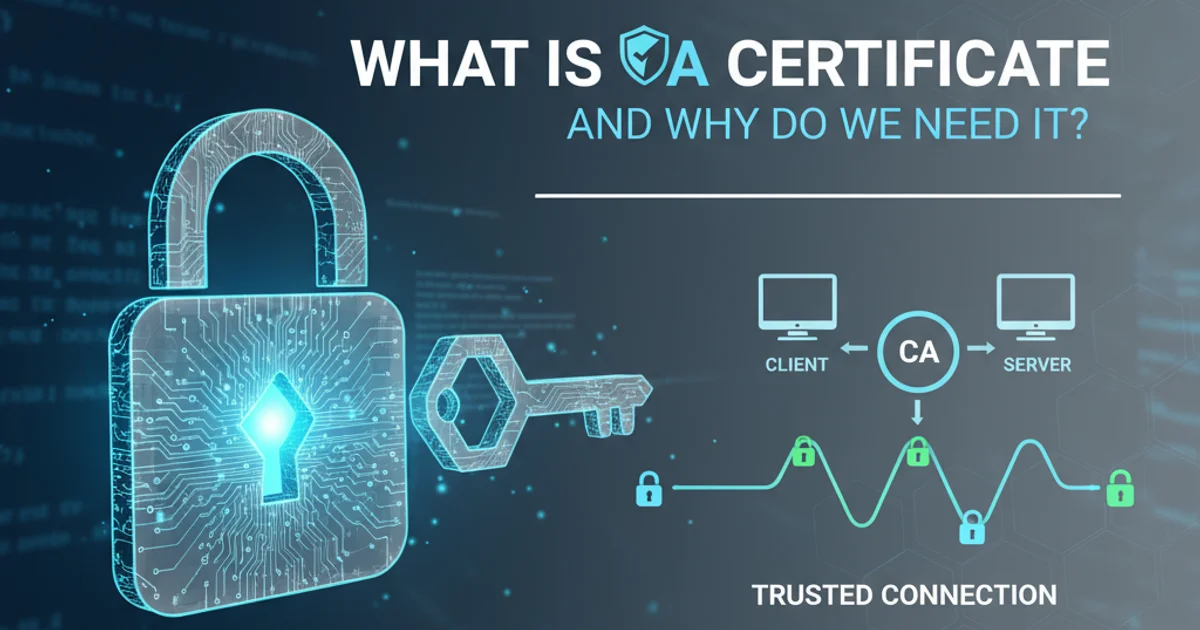What is CA certificate, and why do we need it?
Categories:
Understanding CA Certificates: The Foundation of Digital Trust

Explore what CA certificates are, their role in securing online communications, and why they are indispensable for establishing trust in the digital world.
In today's interconnected digital landscape, securing online communication and verifying identities are paramount. Every time you visit a website, send an email, or conduct an online transaction, you rely on a complex system of trust to ensure your data remains private and that you're communicating with the legitimate party. At the heart of this system lies the CA certificate, a fundamental component of Public Key Infrastructure (PKI). This article will demystify CA certificates, explain their purpose, and highlight why they are essential for maintaining digital trust.
What is a CA Certificate?
A CA certificate, or Certificate Authority certificate, is a digital document issued by a trusted third party known as a Certificate Authority (CA). Its primary purpose is to verify the ownership of a public key by the named subject of the certificate. Think of a CA as a digital notary public. Just as a notary verifies the identity of a person signing a document, a CA verifies the identity of an organization or individual requesting a digital certificate.
CA certificates are part of a larger system called Public Key Infrastructure (PKI), which provides the framework for managing digital certificates and public-key encryption. They are based on the X.509 standard, which defines the format of public key certificates. When you encounter an SSL/TLS certificate on a website, it's been issued by a CA, and its authenticity can be traced back to a root CA certificate pre-installed in your browser or operating system.
flowchart TD
User[User's Browser/OS] --> |Trusts| RootCA(Root CA Certificate)
RootCA --> |Issues| IntermediateCA(Intermediate CA Certificate)
IntermediateCA --> |Issues| ServerCert(Server's SSL/TLS Certificate)
ServerCert --> |Secures Connection to| Website[Website/Server]
Website --> |Presents| ServerCert
User --> |Verifies Chain of Trust| ServerCertSimplified Chain of Trust for CA Certificates
Why Do We Need CA Certificates?
The need for CA certificates stems from the inherent insecurity of open networks like the internet. Without a reliable mechanism to verify identities, malicious actors could easily impersonate legitimate websites or individuals, leading to phishing attacks, data breaches, and a complete breakdown of trust. CA certificates address several critical security challenges:
- Identity Verification: They provide a cryptographic assurance that the entity you are communicating with is who they claim to be. This prevents man-in-the-middle attacks where an attacker intercepts communication by impersonating one of the parties.
- Data Integrity: By using certificates in conjunction with SSL/TLS, data exchanged between parties is encrypted, ensuring it cannot be tampered with during transit.
- Confidentiality: Encryption ensures that only the intended recipient can read the transmitted data, protecting sensitive information from eavesdropping.
- Non-repudiation: In some advanced PKI applications, certificates can be used to prove that a specific individual or entity performed an action, preventing them from denying it later.
Essentially, CA certificates build a 'chain of trust.' Your browser or operating system implicitly trusts a set of root CA certificates. When a website presents its SSL/TLS certificate, your system checks if it was issued by a CA that is directly or indirectly trusted by one of these root CAs. If the chain is valid, the connection is deemed secure.
The Role of Public Key Infrastructure (PKI)
PKI is the overarching framework that makes CA certificates work. It encompasses the policies, procedures, hardware, software, and personnel needed to create, manage, distribute, use, store, and revoke digital certificates. Key components of a PKI include:
- Certificate Authority (CA): Issues and revokes digital certificates.
- Registration Authority (RA): Verifies the identity of certificate applicants on behalf of the CA.
- Certificate Database: Stores certificate requests and issued/revoked certificates.
- Certificate Store: A repository for certificates and certificate revocation lists (CRLs).
- Certificate Revocation List (CRL) / Online Certificate Status Protocol (OCSP): Mechanisms to check the validity status of a certificate (i.e., if it has been revoked before its expiration date).
Without a robust PKI, the concept of digital trust would crumble, making secure online interactions virtually impossible. CA certificates are the tangible manifestation of this trust, enabling secure e-commerce, confidential email, and authenticated access to resources across the internet.
# Example: Checking a website's SSL/TLS certificate chain using OpenSSL
openssl s_client -showcerts -connect example.com:443 < /dev/null
This command displays the full certificate chain, including the server certificate, intermediate CA certificates, and the root CA certificate, for a given domain.